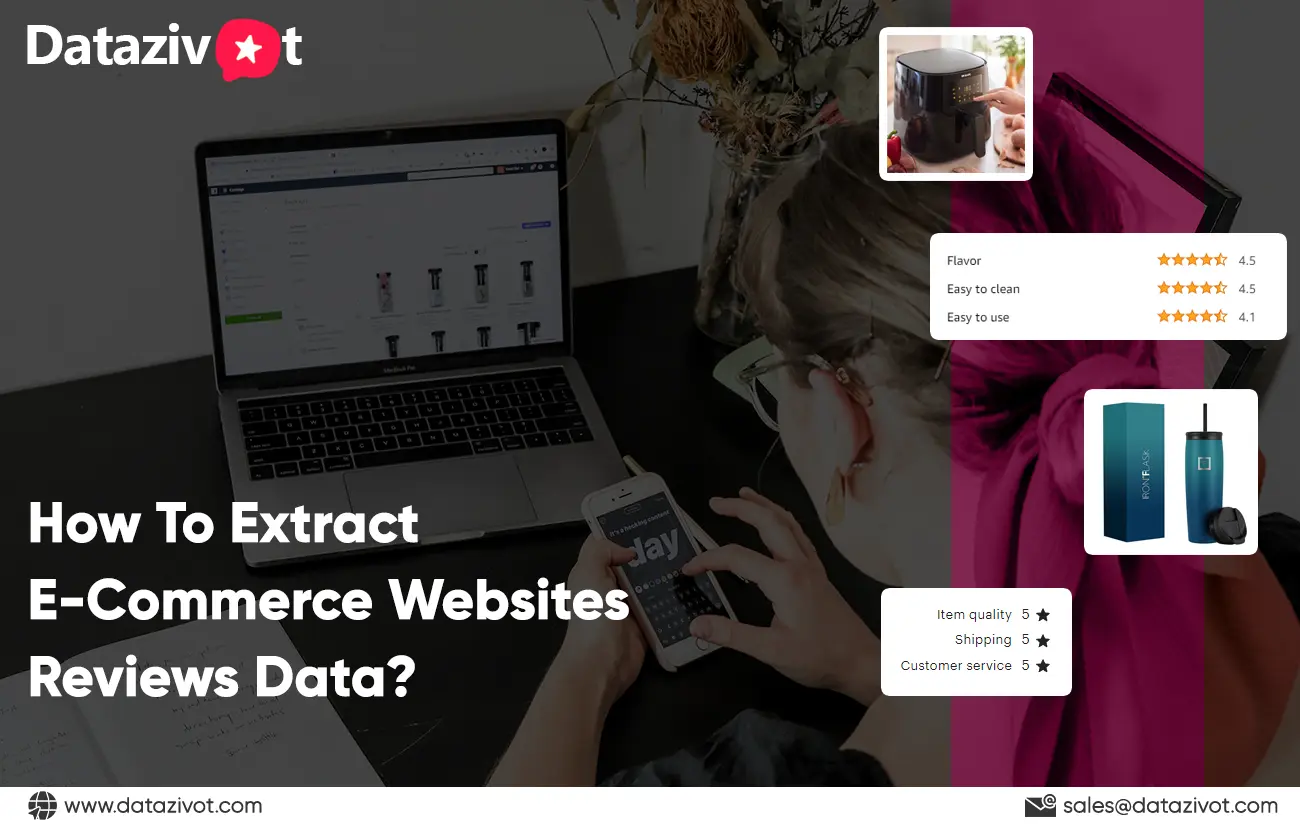
Introduction
In today's digital age, extracting product review data from e-commerce websites has become an essential practice for businesses aiming to understand customer sentiments, improve products, and enhance overall customer satisfaction. Through techniques such as product reviews data collection and product review data scraping, companies can access valuable insights from the vast pool of customer feedback available online.
Businesses can utilize various methods to extract e-commerce websites reviews data, including manual extraction, web extraction tools, or review scraping APIs. Manual extraction involves visiting each product page individually and copying the reviews manually, which can be time-consuming and inefficient, especially for large-scale data collection efforts.
Data collection tools offer automated solutions for extracting product reviews data from e-commerce websites. For example, a leading cosmetics company used this method to identify common complaints about a new product, allowing them to make immediate improvements. These tools can crawl through the website's HTML code, identify review sections, and extract relevant information such as review text, star ratings, reviewer details, and timestamps. This method significantly speeds up the data collection process and allows businesses to gather large volumes of reviews data in a structured format.
While reviews scraping APIs offer a convenient way to extract product reviews data from e-commerce programmatically, it's important to note that they may require some technical expertise to implement effectively. These APIs streamline the data extraction process, offering advanced features such as data normalization, sentiment analysis, and real-time monitoring of review updates.
By leveraging techniques like product review data collection and reviews scraping APIs, businesses can gain valuable insights from e-commerce website review data to inform decision-making, improve products, and enhance customer experiences.
Extract Product Reviews Data from E-Commerce

In today's digital landscape, extracting product review data from e-commerce platforms has emerged as a critical strategy for businesses seeking valuable insights into customer opinions, preferences, and satisfaction levels. Leveraging methods like product reviews data collection and product reviews data scraping, companies can tap into the information embedded within online reviews to inform their decision-making processes and refine their offerings.
Businesses employ various techniques to extract product reviews data from e-commerce websites, including product review data extraction and using reviews scraping APIs. Product reviews data scraping involves using automated tools or scripts to extract reviews from the HTML code of e-commerce websites. These tools can navigate through product pages and capture review text, ratings, reviewer details, and timestamps, efficiently facilitating large volumes of review data collection.
Additionally, businesses can opt to use reviews scraping APIs, which offer pre-built tools and libraries for programmatically accessing and extracting product review data from e-commerce platforms. These APIs streamline the data extraction process and provide features such as data normalization, sentiment analysis, and real-time review monitoring.
By embracing product reviews data collection methods such as product review data extraction and review extraction APIs, businesses can gain actionable insights into customer sentiments, identify emerging trends, and enhance their products and services to effectively meet evolving consumer demands. This approach enables businesses to stay competitive in the dynamic e-commerce landscape by leveraging the power of customer feedback.
Rapid Implementation of Product Review Scraping
Businesses can swiftly implement product review extraction to gain swift access to customer feedback on e-commerce platforms. This entails utilizing tools like reviews scraping APIs or custom scripts to efficiently extract product reviews data from e-commerce websites. By leveraging product reviews data scraping methods, companies can gather valuable insights into customer sentiments, preferences, and satisfaction levels. These insights are crucial for informing decision-making processes, refining product offerings, and enhancing overall customer experiences.
With product reviews data collection techniques, businesses can automate the gathering of large volumes of review data from diverse e-commerce sources. This scalable approach enables rapid analysis and identification of trends, allowing businesses to stay agile and responsive to customer needs.
Implementing reviews scraping APIs offers a convenient and time-saving solution for accessing product reviews data programmatically. These APIs provide developers with ready-made tools and libraries for extracting reviews data efficiently, streamlining the implementation process and reducing development time.
Overall, the rapid implementation of product review collection empowers businesses to swiftly gain actionable insights from customer feedback. By embracing these techniques, companies can stay ahead of the competition, optimize their products and services, and enhance customer satisfaction in the fast-paced e-commerce landscape.
Different Uses of E-commerce Product Review Scraping

Sentiment Analysis
E-commerce product review extraction enables businesses to analyze customer sentiment towards their products or services. By extracting and analyzing product reviews data, companies can gauge customer satisfaction levels, identify areas for improvement, and capitalize on positive feedback.
Competitor Analysis
Product review extraction allows businesses to gather insights into competitors' products, pricing strategies, and customer satisfaction. By extracting product reviews data from competitors' websites, companies can identify strengths and weaknesses, benchmark against industry peers, and inform competitive positioning strategies.
Market Research
E-commerce product review collection supports market research efforts by providing valuable insights into emerging trends, customer preferences, and market demands. By collecting and analyzing product reviews data from multiple e-commerce platforms, businesses can identify market gaps, opportunities for innovation, and areas for product differentiation.
Reputation Management
Real-time monitoring and analysis of product reviews data enable businesses to manage their online reputation effectively. Companies can maintain a positive brand image and build trust with customers by promptly addressing negative feedback, resolving customer complaints, and leveraging positive reviews.
Product Improvement and Innovation
Product review extraction facilitates product improvement and innovation by providing insights into product performance, usability issues, and feature requests. By aggregating and analyzing feedback from e-commerce product reviews, businesses can iterate on existing products, develop new features, and innovate to meet changing customer preferences.
Marketing and Advertising
E-commerce product review extraction supports marketing and advertising efforts by identifying customer testimonials, positive reviews, and user-generated content. By extracting product reviews data from e-commerce platforms, companies can leverage this content in marketing campaigns and advertising materials to enhance credibility and attract potential customers.
What is the Process Involved in Scraping Product Reviews?

Scraping product reviews involves automated extraction of review data from e-commerce websites using specialized tools or scripts. Here's how it typically works:
Web Crawling: A web extraction tool or script navigates through the HTML structure of e-commerce websites, mimicking human browsing behavior.
Locating Review Elements: The scraping tool identifies specific elements on product pages where reviews are displayed, such as review sections or comment boxes.
Extracting Review Data: Once the review elements are located, the extraction tool extracts relevant information such as review text, star ratings, reviewer names, timestamps, and other pertinent details.
Data Parsing and Structuring: The extracted review data is parsed and structured into a usable format, typically in a structured data format like JSON or CSV.
Storing the Data: The scraped review data is stored in a database or file for further analysis and processing.
Handling Pagination and Dynamic Content: When product reviews are paginated or dynamically loaded, the scraping tool handles these scenarios to ensure all reviews are captured.
Rate Limiting and Throttling: Scraping tools often implement rate limiting and throttling mechanisms to control the speed of requests to avoid overloading the e-commerce website's servers and getting blocked.
Monitoring and Maintenance: Continuous monitoring and periodic maintenance of the extraction process are necessary to ensure its effectiveness and adaptability to any changes in the website's structure or anti-scraping measures.
Overall, scraping product reviews involves automated data extraction from e-commerce websites, enabling businesses to gather valuable insights into customer feedback, sentiments, and preferences. However, data extraction must be conducted ethically and responsibly, respecting the website's terms of service and legal requirements.
Conclusion
Leveraging methods such as product reviews data scraping and reviews scraping APIs enables businesses to extract valuable insights from e-commerce platforms. By conducting product reviews and data collection effectively, companies can analyze customer sentiments, monitor competitor performance, and inform strategic decision-making. To harness the power of product reviews data, consider partnering with Datazivot. Our expertise in data extraction and API solutions empowers businesses to gather actionable insights from e-commerce websites efficiently. Contact us today to discover how we can help you extract and leverage product reviews data to drive business growth and success!
